Project Tacoma: Introduction to Gearing - 4x4 and Off-Road Differential Tech
Gearing is the key to delivering useable power from an engine through the drivetrain and to the ground. In 4x4 trucks there are usually transmission gear ratios, transfer case gear ratios and differential gear ratios. Transmissions are an example of gearing that is easy for any driver to understand. Just imagine trying to start a vehicle in 5th gear or attempting to reach 75mph in 1st gear. Gear ratio selection must take vehicle speed and engine speed into consideration and is always a compromise between peak horsepower, torque and fuel efficiency.
The transfer-case is connected to the transmission, redirecting power to the front and rear axles. Two-speed transfer-cases have a high-range and a selectable low-range ratio. The ideal low-range gear ratio depends on the intended use of the vehicle. The low-range in most stock trucks is suitable for light trail use and for driving in mud or sand where wheel-speed helps to maintain forward momentum. Lower gear ratios are used to maintain vehicle control on technical trails. Re-gearing the transfer-case is an excellent way to increase low-range gear-reduction without sacrificing on-road performance because the high-range remains unaffected.
Toyota-specific transmission and transfer-case information
http://www.marlincrawler.com
Power is transmitted from the transfer-case through the driveshaft to the ring & pinion (differential) gears. The numbers in a differential gear ratio indicate the number of revolutions that the pinion gear makes (first number) for each revolution of the ring gear (second number). Think of it as the number of complete rotations that the drive shaft must make in order to rotate the wheel and tire one complete revolution.
Larger tires are more difficult for an engine to turn because they cover more ground per-revolution than smaller tires. Installing significantly oversized tires without changing the stock differential gear ratio will make a truck feel slow and unresponsive (we haven’t been able to use 5th gear in our 4cyl. Tacoma equipped with 3.58:1 gears ever since we installed 33” tires).
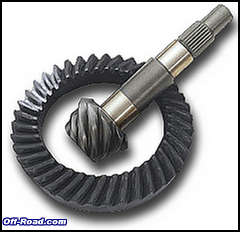
|
The most effective way to restore lost performance due to increased tire size is to re-gear the differentials. Trucks that spend a lot of time off-road often use more aggressive gear ratios to deliver peak horsepower and torque at lower vehicle speeds. But it’s important to understand that gears cannot MAKE power. Any increase in low-end acceleration achieved by re-gearing will result in a comparable decreased top-end performance. As an example, a Tacoma with 4.10:1 gears and 31” tires driving at 65mph in 5th gear would turn an engine at about 2,400rpm, whereas more aggressive gearing (with the same size tires) would require the engine to run much closer to 3,000rpm at the same speed. Running an engine at high rpm’s for extended periods of time will result in decreased fuel efficiency and increased wear on engine components. This is most noticeable at freeway speeds.
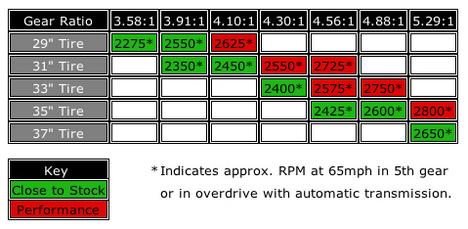
|
We’ve created a chart to illustrate how different gear ratios and tire sizes will affect the performance of 1995+ Toyota 4x4 trucks. The RPM figures given are an approximated average between the different Toyota transmissions in overdrive at 65mph. Click on thumbnail to see the full-size chart in a new window.
Numerically higher gear ratios are often referred to as ‘lower gears’ and both are correct. The confusion can be avoided by explaining that a numerically higher gear ratio effectively provides more gear reduction than numerically lower gears.
The easiest way to check the differential gear ratio in any rear wheel or four-wheel-drive truck is to lift the rear end of the vehicle with a jack and physically rotate the rear tires one complete revolution while counting the number of revolutions that the driveshaft makes. If the drive shaft rotated just over four times, your differential gear ratios would be 4.10:1, etc.
Interco Tire’s gear ratio chart and gear ratio/tire size calculator
http://intercotire.com/html/calculators.htm
Toyota truck gear ratio decoder
http://www.brian894x4.com/Gearratiosanddiffs.html
DIFFERENTIALS & TRACTION
When a vehicle turns, the outside wheels cover a much greater distance than the inside wheels. Without the ability to differentiate wheel-speed, the inside wheel on a driving axle would be forced to temporarily break traction until the vehicle is traveling directly forward again.
OPEN DIFFERENTIAL
Most vehicles are sold with open differentials, which do not offer any additional traction off-road. Power-transfer in an open differential follows the path of least resistance, supplying power through the spider-gears to the wheel with the least amount of traction. This is most evident off-road when one tire breaks traction and spins (like in the mud or when one tire lifts off the ground).
SPOOL
Spools are exactly the opposite of open differentials. They are designed to turn both wheels at the same speed all the time. Spools are lightweight and strong because they are usually machined from a single chunk of billet-steel or aluminum and do not use any moving parts. When used in a rear axle, the inside tire will break traction and chirp around corners, causing under-steer. Spools also cause tires to wear prematurely and can be hard on axle components, but at least the handling is predictable once the driver is familiar with the different characteristics of the vehicle. Spools are rarely installed in the front axles because of the steering problems associated with them.
MINI-SPOOL
Mini-spools and some inexpensive lockers only replace the spider-gears in a stock open differential. Because these low-budget traction-aiding devices reuse the stock carrier, they cannot offer any significant increase in strength. Performance varies by model and application, but generally speaking ‘you get what you pay for’.
CLUTCH-TYPE LIMITED SLIP
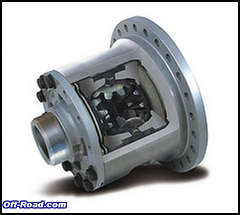
| 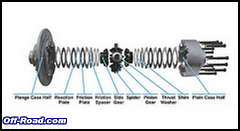
|
Clutch-type Limited Slip Differentials distribute power equally between the drive wheels until the power/traction generated is strong enough to overcome the friction of the clutch. Clutch-type LSD’s are used in many street-performance applications, but they offer limited performance in extreme off-road situations because they do not provide 100% traction and can burn-out due to excessive wheel-spin (like in mud and sand).
GEAR-DRIVEN LIMITED SLIP
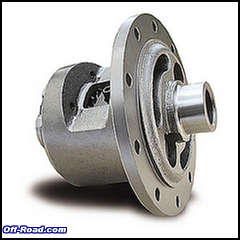
| 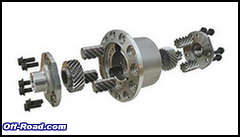
|
A gear-driven or torque-sensing differential is a gear-driven LSD that distributes power equally while still allowing for difference in wheel-speed, as long as both of the drive wheels have an equal amount of traction. This allows for awesome on-road performance and is a significant upgrade from an open differential or clutch-type LSD. Because gear-driven differentials like the Detroit Truetrac (pictured) are gear-driven, there are no clutch-packs to wear out. A gear-driven differential’s performance off-road is still not comparable to a full-locker in situation where there is a complete loss of traction (like a wheel in the air).
MECHANICAL LOCKER
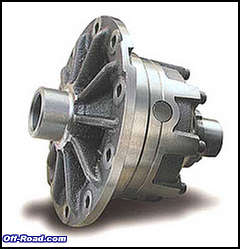
| 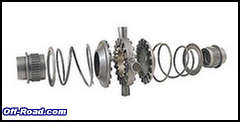
|
Mechanical lockers like the Detroit Locker (pictured) engage automatically based upon power input. They allow the outside wheel to rotate at a different speed than the inside wheel through turns. Due to the simplicity of the design, these lockers are renowned for their strength and durability. The biggest drawback to mechanical lockers is that when they engage (like when accelerating out of a turn or shifting gears on the freeway) the driver must be aware of how these characteristics can affect the vehicle. The effects are much more noticeable in smaller, lightweight, shorter-wheelbase vehicles and are especially concerning in rain and snow/ice. Some people claim that mechanical lockers are unsafe to drive on the street and that’s just misleading. We feel that mechanical lockers are the ideal differential for many off-road applications and shouldn’t be excluded from occasional street use. Besides, anyone driving a highly modified vehicle should be aware of how they will behave.
SELECTABLE LOCKER: OVERVIEW
The most versatile differential is the selectable locker, which operates exactly like an open differential until the driver chooses to engage the locker. When locked, these differentials provide 50/50 power distribution to both wheels (like a spool). Selectable lockers are the ideal differential for vehicles that spend time on and off-road.
ELECTRIC SELECTABLE LOCKER

|
Toyota includes an electronically operated locking rear differential as part of their TRD package on Tacoma trucks. This is an awesome option and allows 100% traction on demand. One of the only downsides is that the TRD rear locker cannot be easily retrofitted to non-TRD Tacoma trucks without using an entire TRD rear axle assembly because the two axles use different third members and housings. The electric motor is also somewhat exposed to damage off-road. There is no front locker currently available from Toyota for Tacoma applications.
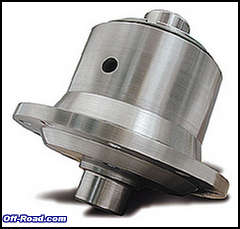
|
Similar to the factory TRD electric locker in concept; the Detoit Electrac is another electronically operated selectable locking differential. But it behaves like a Truetrac LSD when open and like a full-spool when engaged. Unfortunately they are not available for Toyota applications because the electric motor is mounted to the differential inspection cover (which Toyota axles don’t have).
PNUEMATIC SELECTABLE LOCKER
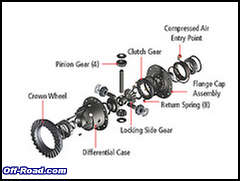
| 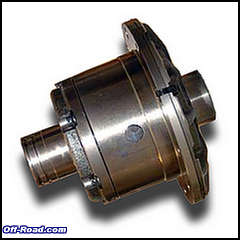
|
ARB is widely recognized as THE selectable locker company. In fact, they manufacture the only aftermarket selectable locking differentials for Toyota trucks. ARB’s air-actuated selectable locking differentials offer open differential on-road drivability combined with 100% traction at the flip of a switch. ARB lockers use 80-85lbs of compressed air to actuate the locker. ARB developed an electric compressor engineered specifically for this. While this does require additional components, installing the ARB compressor and switches is made easier with the included wiring harness. The only real downside to an ARB locker is the price. Superior performance and strength comes at a premium price.
Basic explanation of differentials
http://auto.howstuffworks.com/differential.htm
Toyota axle tech @ Off-Road.Com
http://www.off-road.com/toyota/tech/other/4_axles.html
Toyota differential Information
http://home.4x4wire.com/erik/diffs/
Contact Information: |
ARB USA
http://www.arbusa.com
Tractech Inc. (Detroit)
http://www.tractech.com
TRD USA
http://www.trdusa.com


 Your Privacy Choices
Your Privacy Choices